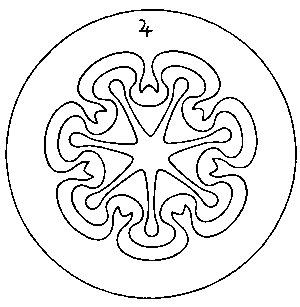Jupiter: Difference between revisions
No edit summary |
No edit summary |
||
| Line 31: | Line 31: | ||
[[Category:World evolution]] | [[Category:World evolution]] | ||
[[Category:Planet]] | [[Category:Planet]] | ||
[[Category: | [[Category:Planetary system]] | ||
[[de:Jupiter]] | [[de:Jupiter]] | ||
Revision as of 14:46, 20 April 2021

Today's Jupiter (ancient Egyptian: Hor-wepesh-taui; Hebrew: צֶדֶק Tsedeq; astronomical sign: ♃) arose from a spiritual-scientific point of view, when the so-called Old Sun's existence was repeated in an abbreviated form during the earth evolution. It consists essentially of gas and heat. Jupiter's sidereal orbital period is 11.86 years.
„Jupiter has a moderate active power because its motion is between the cooling influence of Saturn and the burning power of Mars. It heats and moistens; And because its heating power is the greater because of the underlying spheres, it produces fertilising winds.“
A Great Conjunction of Saturn and Jupiter occurs about every 20 years. Some astronomers and historians suggest that the Star of Bethlehem at the time of Jesus' birth may have been a Great Conjunction in the years 7 to 6 B.C.[1][2] The most recent, spiritually very significant Great Conjunction occurred in the evening of December 21, 2020.
Spiritual Importance

Jupiter is the seat of the Jupiter beings that stimulate the consciousness soul (Lit.:GA 98, p. 198). The Jupiter sphere is the domain of the Spirits of Wisdom. The leading Archangel of Jupiter is Zachariel.
In the human organism, Jupiter's forces have a special effect on the formation and activity of the liver, and in speech they reveal themselves through the vowel O. In plants, Jupiter's influence is reflected in the formation of fruit. As a tree, the maple is associated with Jupiter, and among the earthly metals, tin came into being through the direct influence of Jupiter.
Literature
- Fran Bagenal, T. Dowling, W. McKinnon (Hrsg.): Jupiter: The Planet, Satellites and Magnetosphere. Cambridge University Press, 2004, ISBN 0-521-81808-7.
- Guillaume Cannat, Didier Jamet: Jupiter und Saturn – die schönsten Bilder der Raumsonden Galileo und Cassini. Aus dem Franz. von Gottfried Riekert. Delius Klasing, Bielefeld 2007, ISBN 978-3-7688-1877-3.
- Alexander J. Dessler: Physics of the Jovian magnetosphere. Cambridge University Press, 1983, ISBN 0-521-24558-3.
- John W. McAnally: Jupiter and how to observe it. Springer, London 2008, ISBN 978-1-85233-750-6.
- Rudolf Steiner: Natur- und Geistwesen – ihr Wirken in unserer sichtbaren Welt, GA 98 (1996), ISBN 3-7274-0980-0 English: rsarchive.org German: pdf pdf(2) html mobi epub archive.org
 |
References to the work of Rudolf Steiner follow Rudolf Steiner's Collected Works (CW or GA), Rudolf Steiner Verlag, Dornach/Switzerland, unless otherwise stated.
Email: verlag@steinerverlag.com URL: www.steinerverlag.com. Index to the Complete Works of Rudolf Steiner - Aelzina Books A complete list by Volume Number and a full list of known English translations you may also find at Rudolf Steiner's Collected Works Rudolf Steiner Archive - The largest online collection of Rudolf Steiner's books, lectures and articles in English. Rudolf Steiner Audio - Recorded and Read by Dale Brunsvold steinerbooks.org - Anthroposophic Press Inc. (USA) Rudolf Steiner Handbook - Christian Karl's proven standard work for orientation in Rudolf Steiner's Collected Works for free download as PDF. |
References
- ↑ Burkard Steinrücken: The Star of Bethlehem - How far can serious astronomical interpretation go? (German), [[WikipediaDE:Westfälische Volkssternwarte|Westfälische Volkssternwarte und Planetarium Recklinghausen], 26 March 2003, retrieved 23 December 2017 (pdf; 1.8 MB).
- ↑ Johannes Kepler: De Stella nova in pede Serpentarii (1606)

